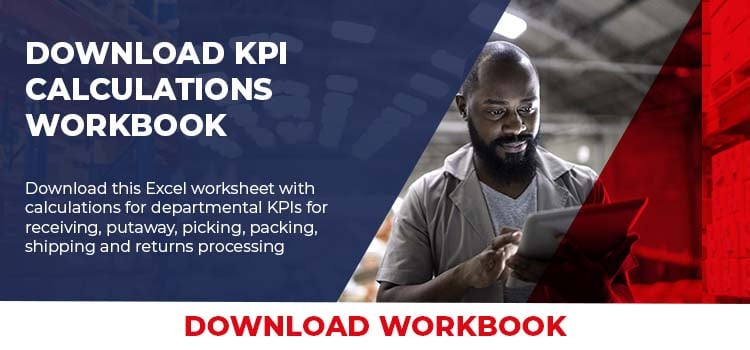In the ecommerce world of point, click and deliver, are you monitoring Direct To Customer (DTC) service level metrics that will help you meet the high expectations of customers?
Amazon has set high performance standards for fast delivery and little or no shipping cost. Amazon is already capable of offering same-day and one-day delivery to 82% of the total U.S. population, according to RBC Capital Markets. Their vast delivery network is a result of significant investments over the past four years, allowing same day delivery in hundreds of markets.
In our consulting work, one of our major initiatives is for our clients to be more responsive in terms of quick ship options. Many of our clients are evaluating the extension of additional distribution centers either through in-house internal facilities or through using third-party fulfillment to be closer to customers.
Selected warehouse service levels
Below are selected service level metrics for fulfillment from six companies, which apply to all warehouse operations regardless of type of business. These companies offer a wide range of products available through the ecommerce channel. We see a wide range of standards and results within distribution operations. What are the service level metrics you measure, and what are the standards and results consistently achieved?
| Fulfillment Metrics | A | B | C | D | E | F |
| Initial order fill rate | 92% | 89% | N/M | 60% | 67% | 82% |
| Orders shipped same day (%) | 91% | 92% | N/M | 20% | 67% | 60% |
| Orders shipped error free (%) | 99.2% | 97% | 99.6% | 99.9% | 95% | 100% |
| Dock-to-stock time | Same shift | Same shift | N/M | 2 days | Next day | Next day |
| Returns processing (hours) | 3 | 5 | 4 day | 2 | 2 | 2 |
N/A = not measured
Source: F. Curtis Barry & Company, all rights reserved.
This is a sampling of service level metrics which have been uniformly defined and reported.
Defining the metrics
Here is the definition of each metric and some comments about the companies’ results.
Initial order fill rate: This is an inventory control metric that reports a warehouse’s ability to ship a complete customer order based on item availability. This is the percentage of orders shipped completely within a 24-hour period based on in-stock inventory. It’s an excellent measure of customer service at the customer order level. If you take in 1,000 orders today and ship 700 of them (all lines and quantities), you have a 70% initial order fill rate. Learn more about order fill rate and its importance to proving the best customer service here.
Company A sells many of the same products year after year, and add few new products annually. Therefore, it has SKU sales history to plan forecasts and has item reorder-ability. Company D is a fashion apparel retailer with a high percentage of new products, including exclusive designs and limited ability to reorder in season. We would expect this type of company to have a lower fill rate. Company E uses vendor drop ship for many products.
The key to improving the in stock rate of products is having effective inventory planning and control systems.
Orders shipped same day: This is the percentage of orders shipped out the door daily whether complete or not. Companies D, E and F have lower numbers and will require additional fulfillment budget to improve this metric. Industry leaders like Crutchfield (selling electronics, including mobile audio and video equipment for the automobile, along with speakers, televisions, and other electronics for home or portable use) and backcountry.com (outdoor specialty products) are shipping 100% of their orders every day to be competitive and responsive.
Orders shipped error free: The four companies with error-free rates of 99%+ are using barcode scanning throughout their operation, and voice picking in a couple of cases. Studies consistently show that wrong orders cost $35-$50 each to correct, a figure that can balloon quickly. What isn’t in the calculation is the cost of losing a customer and their lifetime value due to order errors or late shipments. Our blog, “How to Reduce Fulfillment Errors in Your Warehouse Operation," discusses this topic.
Dock-to-stock time: This the time required from receipt through put away. Best-in-class is two hours or less. Our recommendation is to try and clear receipts during the same shift, if at all possible, which may mean spending more on fulfillment labor. The longer it takes to process, the more dock and receipt staging area is required. Here are 11 ways to reduce dock to stock time.
Returns processing: This includes inventory and customer service processes involved with receiving returns back into the facility, opening cartons, product inspection and product disposition, preparation of customer paperwork for refund, credits and exchanges. Ideally, we like to see returns processing happen in 8-12 hours after receipt.
KPIs identify areas to improve
What warehouse metrics have you adopted to gauge the level of customer service your fulfillment center is providing? Are they in line with customer expectations for quick service and delivery? What changes to your data collection and management reporting are necessary to obtain KPIs and drill down into department and employee productivity?
Have you taken the first step? To paraphrase the famed British scientist Lord Kelvin:
“You can’t improve something you haven’t measured”.
This is the first step to identifying where you should make process changes.







SHARE